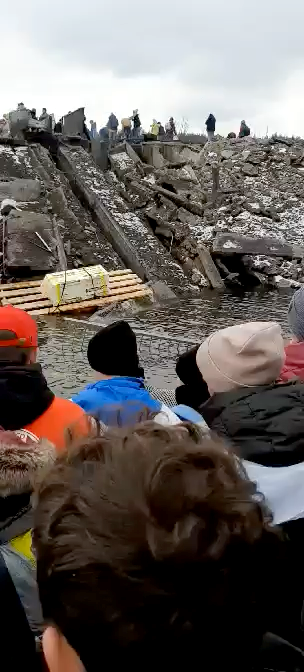Cars with Ukrainian plates parked in the streets, women and children walking around asking for directions, and many volunteer groups on social media collecting essentials for the newly-arrived in Malmö, a city in southern Sweden that is no stranger to humanitarian crises.
Located on the border with Denmark and linked to it by the landmark Øresund Bridge, – known in Western pop culture thanks to the acclaimed detective TV series The Bridge – the third-largest city in Sweden with a population of 344,166 is just 20 minutes from Copenhagen Airport and another 20 minutes from its capital, Copenhagen.
It is also among the main entry points to one of the most immigrant-friendly countries in the European Union.
During the Yugoslavian War in the 1990s, Sweden took in hundreds of thousands of Bosnians, Croatians, and Serbs.
In 2015, it faced an influx of Syrians and other refugees, many of whom traveled to Sweden via Germany and Denmark, taking trains across the Øresund Bridge and forcing its government to install border controls at its ports as well as the Hyllie train station.
It ended up receiving the most asylum seekers globally in 2015 per capita.
Seven years after the crisis that helped the anti-immigrant Swedish Democrats become the third-largest party in Riksdag, Sweden, part of the Temporary Protection Directive introduced by the EU is once again welcoming refugees.
This time those fleeing the brutal war began by Russia on February 24.
Sitting inside a neat, spacious building at the Swedish Migration Agency’s temporary housing facilities on the outskirts of Malmö, one of these refugees, Olena Shavrina from Kyiv, smiles because she is finally in safety, a privilege she was deprived of just a few weeks ago.
When the war started, she left her second apartment in the town of Hostomel located near the cargo airport that the Russians attempted to occupy on the first day of war.
“At first, it felt so surreal. There were helicopters flying everywhere. We were filming it. We did not fully realize the implications of what was going on,” she told me with her face reflecting a spectrum of varying emotions toward her own memories. “But I still told my mom to pack her things and leave for the small town of Dymer nearby.”
However, the Russian army soon reached that town. And their mood was blood-thirsty.
“We were standing in the field trying to connect to the mobile network. That’s when they came, pointing guns at us and screaming to fall down onto the ground. Then they grabbed our phones and started checking them. I have never felt this scared in my entire life,” admits Olena. “One lady got effectively paralyzed by fear. When we were allowed to get up, she was unable to unfold her arms that she used to cover her head with. A man next to her had to forcefully unwrap them for her.”
Unwilling to wait for Russia’s next move, she was desperate to get out and seek shelter.
During the evacuation, which she found out about by pure accident, she grabbed her essentials and convinced a driver to give a lift to her mother before facing a Russian soldier once again at one of the block posts: “I was trying to find my mom because I had to walk on my own. I couldn’t, so I ran up to one of them and confronted him, asking whether he had seen my mom. He was a kid. Thank God, he did not shoot me because the words I used that day were heavy.”
After finding her mother Olena, alongside other evacuees, had to jump into the water to transport others on a wooden deck before finally receiving an inflatable boat: “The Ukrainian soldiers blew up a local bridge to stop the Russians from advancing, so we were standing in an open area that Russians shelled time and again. The situation was terrible.”

Ukrainians fleeing Russia’s invasion onslaught in Hostomel, Kyiv Region, on Feb. 24 (Video credit: Olena Shavrina)
Once Olena had managed to reach Western Ukraine by train from Kyiv, the first thing she did was to enjoy a coffee in a café: “I wanted to pretend that nothing is happening, that everything is normal before leaving for Poland and arriving in Sweden where we have friends.”
While we talk, another Olena descends downstairs and joins our conversation. Asked how she is doing, she smiles and says “amazing”, adding with a slightly grimmer face expression,
“It doesn’t make any sense to cry, does it?”
Olena fled the city of Kryvyi Rih in Dnipropetrovsk Region. Commenting on the Russian army’s attempts to make a foray into the region, she laughs that they will have a hard time encircling her city: “It is so long, it is virtually impossible.”
The subject of politics emerges eventually emerges, and we touch upon President Volodymyr Zelensky’s attitude and actions.
“Oh, I know him,” Olena blurts out, adding that Zelensky, who is also from Kryvyi Rih,
used to study in the same university with her. “I am genuinely surprised and proud that he turned out to be a leader of this kind. He was more about laughs and talk back in the day. Now, look at him. Other politicians fled but he stayed. His family too.”
“So, what’s the plan now?” I ask both as the conversation is nearing its end. The answer is almost immediate: to normalize lives and find jobs to support themselves.
The first Olena is yet to find permanent accommodation and ensure that her mother has access to medical care. She praises Swedes for being so helpful: “Everyone is very nice. I feel welcomed.”
The second Olena is planning on learning the language and re-doing her degree in medicine: “I might as well do something useful until things calm down.”
We hug each other and promise to keep in touch.
